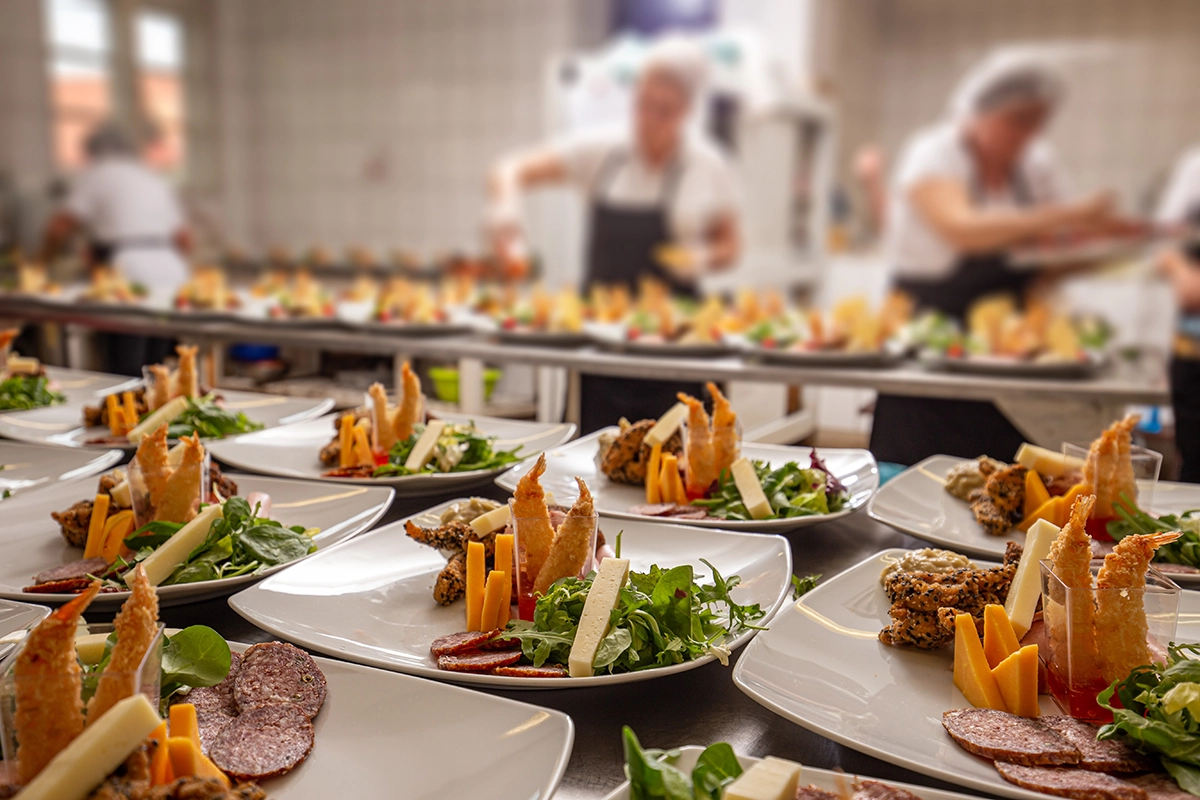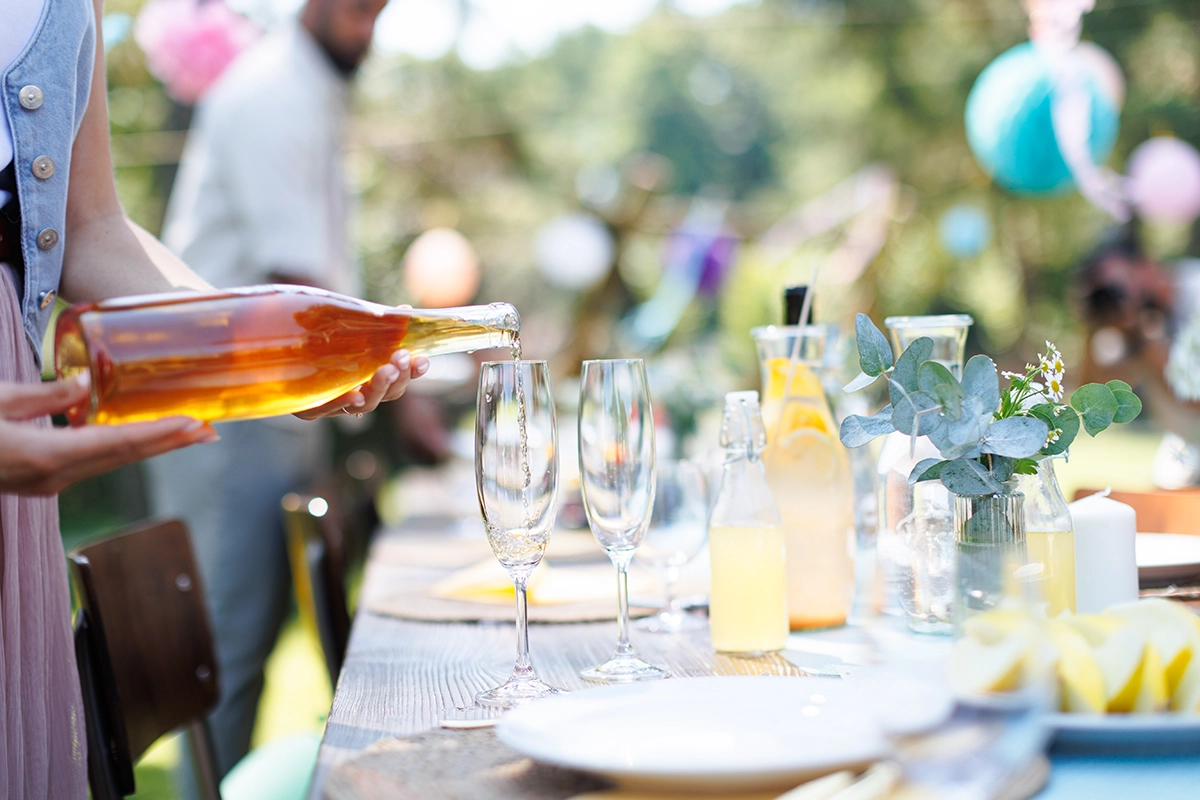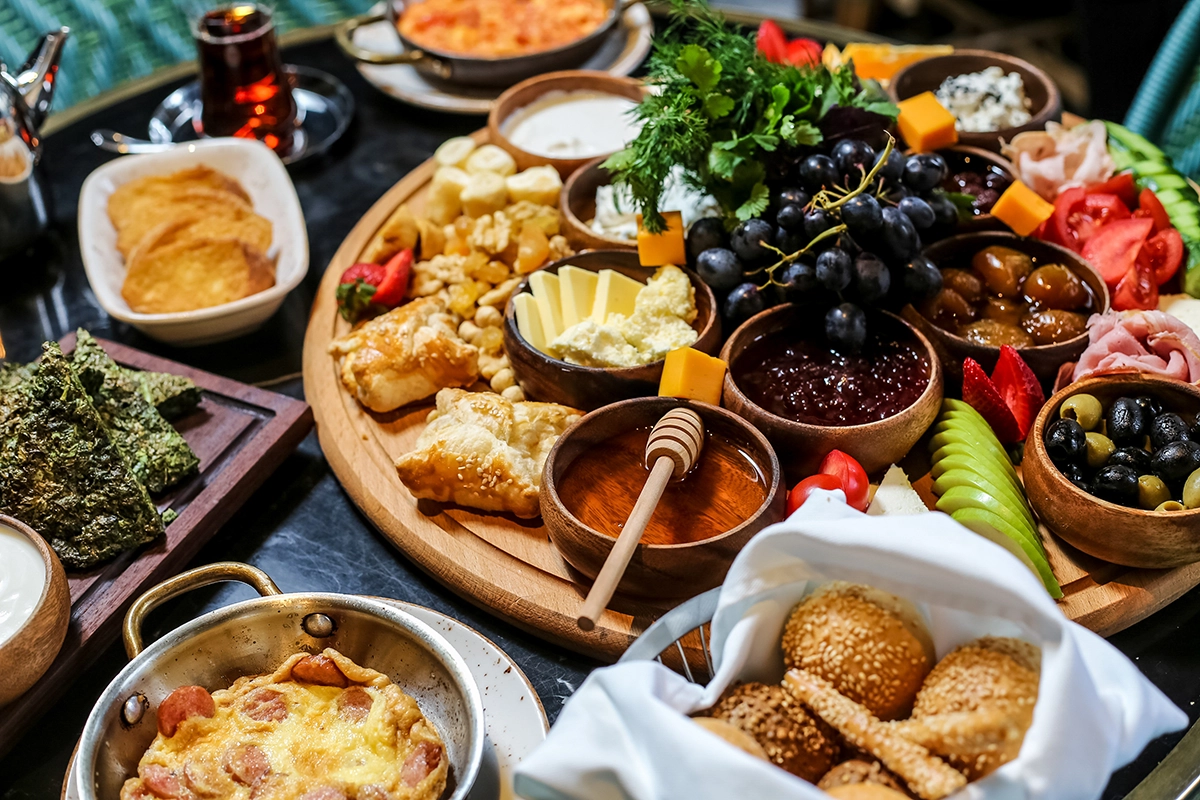Table Of Contents
The Ultimate Catering Checklist for Any Type of Event
Introduction
Imagine this: guests are arriving, everything’s on schedule… but the coffee station has no cups. The servers scramble. Someone’s calling the rental company. Meanwhile, caffeine-deprived guests are getting restless. It’s a small detail—but it’s the kind of thing that can derail an otherwise perfect event.
That’s why a catering checklist isn’t just helpful—it’s essential. Whether you’re planning an intimate backyard dinner or a 300-guest corporate gala, having a detailed, go-to list can be the difference between cool confidence and behind-the-scenes chaos. It ensures quality, prevents last-minute panic, and shows clients and guests that every moment has been thought through.
This guide is designed for anyone who wears the “event host” hat—brides and grooms, executive assistants, nonprofit organizers, and everyone in between. Whether it’s your first rodeo or your fiftieth, this is your master blueprint.
Inside, you’ll find a start-to-finish breakdown: every item to check, every question to ask, and every box to tick—no matter the size, style, or scope of your event. Let’s dive into the first step that sets the tone for everything else: the essential event details.
1. Define the Basics: Event Details That Shape the Rest
Before menus are chosen and tables are set, it all starts here. These are the foundational facts that drive every catering decision—get them right early, and you’re already ahead.
- Confirm the event date, time, and location
This seems obvious, but confirm it twice. Dates can shift, venues change—lock it in with a contract, then reconfirm closer to the date. Factor in setup and cleanup windows, too. - Secure client contact information and communication preferences
Get everything: phone, email, emergency contact, and the preferred method of communication. You don’t want to be guessing how to reach your client when a delivery truck is circling the block. - Finalize the guest count (and build in a “ghost guest” buffer)
Your headcount drives food quantity, staffing, rentals—everything. Always add a small cushion (typically 5–10%) to account for unexpected plus-ones or late RSVPs. - Record start, service, and teardown times
Clarity here is key. When are guests arriving? When does food service begin? When does teardown start? Knowing this keeps kitchen timing, staffing, and rental pickups in sync. - Note dietary restrictions and preferences
Collect this information early and in detail. Vegetarian, vegan, gluten-free, nut allergies, religious dietary laws—flag them all. A good menu makes everyone feel considered.
2. Budget + Menu: Marrying Taste with Costs
Let’s talk numbers—because no matter how lavish or low-key your event, budget defines the flavor of your catering. Start here before tasting menus and Pinterest boards take over.
- Determine the catering budget (based on event type and scale)
A good rule of thumb: catering can consume 25–30% of the overall event budget. But that flexes. Corporate breakfasts? Lower. Full-service weddings? Higher. Establish your ceiling early so the rest can scale smartly.

- Match the menu with the event’s vibe
Elegant plated dinner? Or a casual taco bar? The menu should reflect the mood. A fundraising gala calls for refinement; a backyard birthday might scream sliders and skewers. Match the food to the atmosphere, not just the appetite. - Go seasonal and local when possible
Not only does this support local growers and reduce costs, but it also guarantees fresher, more flavorful ingredients. Bonus: it helps menus stand out with a sense of place and time. - Clarify all dietary accommodations upfront
Build inclusivity into the meal plan—clearly mark vegetarian, vegan, gluten-free, and allergy-conscious items. If one guest can’t eat anything on the menu, it’s not just awkward—it’s a hospitality fail. - Choose your service style: buffet, plated, food stations, or family-style
Your service format impacts staffing, rental needs, and flow. Buffets are efficient and guest-friendly. Plated meals are elegant but labor-intensive. Food stations add variety and visual appeal. Family-style is intimate but space-hungry. Choose what complements your space and goals.
3. Venue Logistics: Know the Terrain
Before you can feed guests, you need to understand where you’ll do it. Venues are rarely plug-and-play—each comes with quirks, perks, and practical limitations. Scout smartly and plan accordingly.

- Scout kitchen facilities, refrigeration, and storage areas
Some venues have full commercial kitchens; others, a single electrical outlet and a dream. Know what’s available, what’s lacking, and whether you’ll need to bring in portable equipment or generators. - Check for accessibility and guest flow
Is the venue ADA-compliant? Are there ramps, elevators, clear signage, and accessible restrooms? Make sure the space accommodates all guests, not just the mobile and able-bodied. - Inventory tables, chairs, outlets, and water access
Don’t assume anything is included. Some venues offer full setups; others are a blank canvas. Count tables, chairs, and linens. Check power sources and water availability for coffee stations, dishwashing, or portable sinks. - Confirm permits, licenses, and insurance requirements
Depending on the location and food type, you may need health permits, alcohol licenses, or proof of insurance. Get this information before contracts are signed—and always over-prepare.
4. Supplies & Equipment: The Full Gear Breakdown
Even the most brilliant menu can fall flat without the right tools to prep, serve, and present it. This section is your all-access inventory pass—the things you need to cook, serve, style, and clean, whether you’re going full fine-dining or keeping it casual.
A. Table Settings
- Linens, flatware, glassware, charger plates, salt & pepper shakers, water pitchers
These are the touches that elevate the experience from basic to polished. Don't forget the details: water pitchers for each table, and yes—matching napkins do matter.
B. Cooking + Holding Equipment
- Portable grills, induction burners, warming cabinets
If your venue’s kitchen can’t handle your prep list, bring the heat. Literally. Make sure your gear is up to code and compatible with the space.
C. Serving + Display Equipment
- Chafers, serving trays, cake stands, risers, chalkboard signs
These items do double duty: they keep food hot and make your spread look photo-ready. Signage helps with dietary clarity and cuts down on questions.
D. Disposables (for casual setups)
- Foil pans, paper napkins, plastic cutlery, cocktail picks
Not every event needs china. Disposables work well for outdoor, drop-off, or budget-conscious events—but choose sturdy and compostable options when possible.
E. Beverage Station
- Ice, dispensers, coffee urns, airpots, stirrers, cream, sugar, drink mixes
A forgotten stirrer or ice bucket can derail a drink station. Build a full list for hot and cold beverage setups and assign someone to monitor stock throughout the event.
F. Furniture & Decor
- Tables, cocktail tables, benches, bars, tents, centerpieces
Style and function meet here. Make sure the number and size of tables align with your guest count and your food display plan. Bonus points for lighting, floral, or themed decor touches.
G. Cleaning & Janitorial
- Trash bins, liners, handwashing stations, sanitizers, towels
The unglamorous but essential side of catering. Don’t assume the venue will supply these. Always bring extras—and always have a cleanup crew plan in place.
5. Staffing & On-the-Ground Execution
An event lives or dies by its crew. Even the best food can’t save you if the service is slow, sloppy, or short-handed. This section ensures the human element of your catering plan is tight, trained, and ready to deliver.
- Identify staffing needs: chefs, servers, bartenders, bussers
The right headcount depends on your service style. Plated dinners need more servers. Buffets? Fewer staff, but someone needs to manage the flow. Don’t forget bartenders, kitchen help, and on-site leads.
- Coordinate arrival times and uniform expectations
Your team should arrive early enough to handle setup and be ready before guests arrive. Communicate clearly about uniforms or dress code—nothing kills the vibe like a bartender in board shorts at a black-tie event.
- Build a shift schedule: setup, service, and teardown
Who’s arriving when? Who stays through cleanup? Who handles late-night breakdown? Write it down, confirm it twice, and post it somewhere visible on event day.
- Prepare tip envelopes or gratuity disbursement
Factor this into your final budget. Whether it’s cash envelopes or included in payroll, have a system in place. A well-tipped team is a happy team—and they’ll show it in their service.
6. Timeline & Communication Plan
Even the best plans fall apart without clear communication and a clock-tight timeline. This is where organization meets orchestration. A smooth event hinges not only on preparation, but on everyone knowing what’s happening, when, and who’s in charge.
- Create and share a detailed run-of-show (with buffer times)
Break down the entire event by the hour—or even the half-hour. Include setup, staff meals, guest arrivals, food service windows, speeches, and breakdown. Then pad it. Unexpected delays will happen.
- Confirm delivery and pick-up logistics
Know who’s dropping off what, when, and where. Rentals, linens, AV equipment—don’t assume they’ll show up on time unless it’s clearly documented. Also confirm when everything needs to be off-site post-event.
- Communicate the checklist and timing with vendors, venue staff, and your team
Everyone should be reading from the same playbook. Send out the finalized schedule, vendor contacts, and setup notes at least 48 hours in advance. Reconfirm the morning of the event.
- Assign a point-person or “event quarterback”
You can’t be everywhere at once. Designate one calm, capable person to answer questions, solve problems, and keep things on schedule. Equip them with a walkie or group text and a copy of the master plan.
7. Final Checks: Pre-Game Day Prep
The finish line is near—but this is where pros distinguish themselves. Final checks are about catching the small things before they become big things. It’s your last lap before guests walk in.
- Confirm all orders: food, rentals, décor, beverages
Triple-check your invoices and receipts. If it’s not written down and confirmed, it doesn’t exist. Contact vendors to verify everything’s en route—and correct quantities are packed.
- Final RSVP count and guest list adjustments
Call or email any late responders. Adjust seating, portions, and staffing based on final numbers—and don’t forget that “ghost guest” buffer.
- Pre-assemble items and prep food where possible
Get ahead of the rush. Pre-slice garnishes, label boxes, and organize non-perishables. Group items by station or timeline so unpacking on-site is seamless.
- Test all tech and equipment
Power up the coffee urns, warmers, sound systems, lighting rigs—everything. Don’t wait until guests are arriving to discover an outlet doesn’t work or the mic cuts out.
- Walk through the space the night before or early day-of
Get the lay of the land while it’s still quiet. Visualize the flow: where will the food be staged? Where are bottlenecks likely? Adjust layout or timing now while you still can.
8. Post-Event Wrap-Up
The guests are gone, the music’s faded, and the lights are coming back on—but your job isn’t quite done. The post-event wrap-up is where true professionals shine. It’s how you leave a venue spotless, a client impressed, and your future events even better.
- Cleanup protocols and trash disposal plans
Have a cleanup strategy in place before the first plate hits the table. Who handles garbage removal? Are there designated bins or does everything go off-site? Don’t leave it to chance—or worse, to the client.
- Collect feedback from staff and clients
The event may be over, but the learning continues. Ask your team what went well and what could improve. Encourage honest feedback from clients—these insights shape future perfection.
- Settle final payments and gratuities
No one likes chasing money—or being chased. Confirm all invoices are accurate, tips are distributed fairly, and every vendor is properly thanked and paid.
- Pack and inventory leftover supplies/equipment
Avoid scrambling at your next gig by properly packing up now. Label storage bins, inventory rentals, and note anything missing, broken, or in need of replacement.

Conclusion
At its core, a catering checklist is more than just a task list—it’s your insurance policy against chaos. It turns “oops” moments into “already handled,” and gives you peace of mind from setup to send-off.
Frequently Asked Questions
1. What’s the biggest mistake people make when planning event catering?
One of the most common missteps is underestimating how long setup and service actually take. People assume food magically appears at the right time, but without a timeline that accounts for prep, staging, and staff flow, things can unravel quickly. Always build in buffer time and confirm every vendor’s arrival slot.
2. How do I choose between buffet, plated, or stations for my event?
Think about your guest experience and space layout. Buffets are efficient and casual, stations offer variety and visual interest, and plated dinners feel upscale but require more staff. There’s no wrong choice—just one that better suits your crowd, venue, and service budget.
3. Do I need to provide meals for the catering staff?
Yes, if your event runs several hours, especially during mealtimes. While they may not eat what guests are served, offering a staff meal (even something simple) is standard practice. It keeps your team energized and morale high.
4. What if I don’t have a kitchen on-site? Can I still offer great catering?
Absolutely. Many caterers are equipped with portable burners, grills, and warming cabinets to serve fresh food anywhere. The key is knowing your venue’s limitations early—then building your menu and equipment list accordingly.
5. Should I tip catering staff separately from the company’s service fee?
It depends. Some companies include gratuity in their contract; others don’t. If it’s not already factored in, 15–20% of the food and beverage subtotal is customary, either split among staff or given directly to leads. Always check your invoice—and when in doubt, ask.








